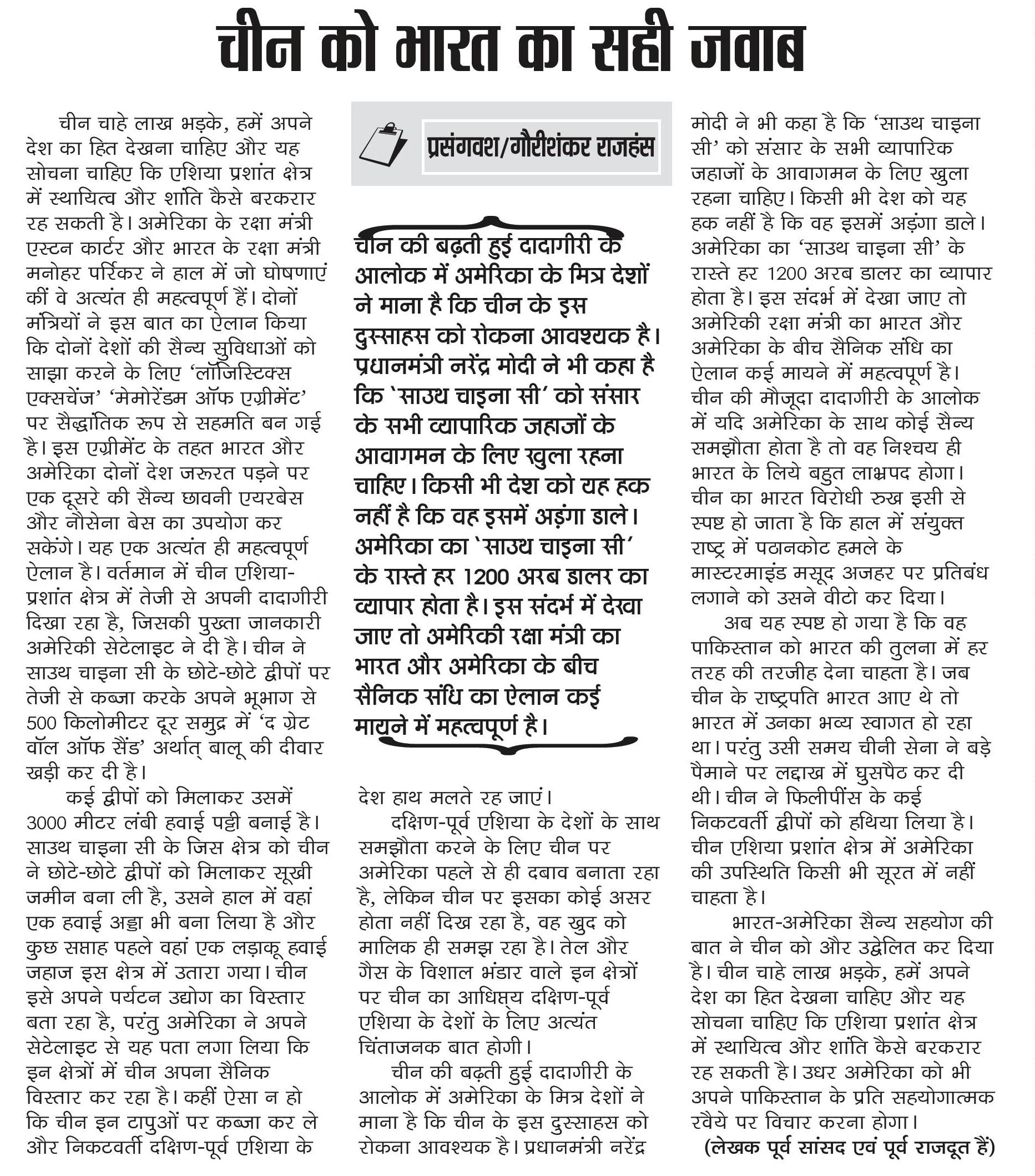
25-04-2016 (Important News Clippings)
To Download Click Here.
न्यायपालिका के प्रति बजट निर्माताओं की बेरुखी
मुख्य न्यायाधीशों की हमेशा एक शिकायत रही है कि न्यायपालिका के लिए बजट में पर्याप्त आवंटन नहीं होता है। न्यायपालिका के लिए आवंटित रकम महज 0.2 से 0.4 प्रतिशत बताई जाती है। यहां तक कि वर्षों से उपेक्षित सामाजिक, स्वास्थ्य एवं शिक्षा क्षेत्रों के लिए भी अब बजट में आवंटन बढ़ा दिया गया है। थोड़ी हैरत वाली बात यह भी है कि रक्षा क्षेत्र के लिए बजट में 10 प्रतिशत आवंटन हुआ है लेकिन पिछले करीब 50 साल में देश ने युद्ध का सामना नहीं किया है। रेलवे के लिए अलग से बजट की व्यवस्था की गई है।
India must build intellectual property
April 26 is World Intellectual Property Day. For most Indians, intellectual property is a combination of Pierre-Joseph Proudhon and Robin Hood. The French anarchist famously declared property to be theft. Indians, few of whom put in the hard slog required to create intellectual property, readily agree, and are eager to do to the owners of intellectual property what Robin Hood did to the rich. Karl Marx, no fan of property himself, pronounced Proudhon to be confused: you can steal something only if it already belongs to someone, meaning property must precede theft and so cannot be theft. Indians are equally wrong to disrespect intellectual property.
It is not enough to be formally compliant with global regimes on intellectual property rights. India is WTO compliant on the subject. And its patent law’s Section 3(d), requiring a novel form of a patent-protected molecule to show improved therapeutic efficacy for it to secure a separate patent, is a model for the rest of the world, even if multinational pharma hates it. The problem in pharma is confined to a trigger-happy attitude towards compulsory licensing that eschews room for negotiated price reductions backed up with bulk purchase commitments orchestrated by the government.
The emerging problem area is electronics, particularly telecom. Indian companies glibly disregard the need to license technologies, leading to legal disputes with patent holders. The larger problem is consistent failure by Indian firms to carry our research and development (R&D) that would create intellectual property. Trade, tariff and tax policies that discourage genuine domestic value addition and incentivise masquerading trade as manufacture, are to blame as well.
For Make in India to be something more substantive than simple assembly of complex parts produced elsewhere, India has to focus on domestic R&D and creation of intellectual property. Overhaul of university funding and focus, legal clarity on and protection of intellectual property and rational trade and tariff policy — action is called for on multiple fronts.
Not population but social development
Andhra Pradesh chief minister Nara Chandrababu Naidu wants everyone to have more children. He worries that India is rapidly greying and would soon end up in a situation akin to ageing Japan. Naidu’s advice is gratuitous and in poor taste.
In 2013, the average Indian woman gave birth to 2.3 children — a number called the ‘fertility rate’. This is still above what demographers call the ‘replacement rate’, which measures the average number of children per woman required to keep the population stable, reckoned to be 2.1. So, Naidu need not worry himself sick about India turning into Japan anytime soon.
India’s population growth is falling as incomes grow and social conditions change for the better. In 2013, for example, the poorest and least socially progressive states had the highest fertility rates: Bihar’s was 3.4, Uttar Pradesh (3.1), Madhya Pradesh (2.9) and Rajasthan (2.8). The social condition, educational qualification and employment opportunities of women in these states are appalling. Without exception, these states are economically backward.
Unsurprisingly, socially progressive West Bengal (1.6), Tamil Nadu and Delhi (1.7) and Kerala (1.8) have the lowest fertility rates in India. The conclusion is obvious: as incomes rise, couples decide to invest more in their children, rather than producing armies of future farmhands. This fits with the halfcentury-old insights of Gary Becker, who won the Nobel Prize for economics in 1992, for his work on ‘human capital’.
The people of Andhra Pradesh, where the fertility rate is 1.8, on par with Kerala, choose to have fewer kids because they want to invest more in each child. That way, these parents hope their children will be smarter and have more opportunities than they ever had. Who is Naidu to tell them otherwise? Get social development right, population will right itself.
Cap mania: Instead of building capacity for a 21st century India, we seem headed back to the 1970s
Prime Minister Narendra Modi once said that India could become a $20 trillion economy. This had seemed an intellectual breakthrough at the time because our political class is conditioned to think in terms of shortages, restrictions, bans, poverty. Material poverty follows intellectual poverty. And tackling shortages of a desired entity by restricting demand instead of looking to boost supply is a hallmark of that povertarian mindset. Unfortunately that povertarian mindset still rules the roost, including in BJP.
It’s very worrying that the Centre is considering capping registration of new vehicles and restricting purchase of second cars (use of new cars in place of old ones will curb rather than increase air pollution). This is on the heels of the odd-even scheme being forced down Delhi’s throat, despite discouraging data on its ability to tackle either pollution or congestion. What authorities don’t get is that people ply private vehicles because public transport isn’t adequate for their needs.
In fact, even if new modes of public transport should come up on their own without the state doing anything, government can go all out to quash them. Thus, the Delhi government has told the Delhi high court that the new app-based cab aggregators are operating “illegally” in the city. India has too long been hobbled by the command and control mindset, where instead of playing an enabling role and expanding horizons for citizens, the state relies instead on petty prohibitions – whether it comes to cars, education, healthcare, food, drinks or even cricket matches.
From Haryana to Maharashtra, the beef taboo has become the equivalent of blasphemy in Pakistan. The ban on alcohol is spreading across states in complete defiance of social or economic logic. In Delhi schools are being told they can’t fire any teacher without sarkari approval (which is to say, not at all) and they must also report every chair, library book and petri dish to the sarkar. In healthcare, the Centre now wants to stop doctors from practising abroad. This is despite India having many medical centres of excellence and being established on the medical tourism map due to the expertise of doctors who have worked abroad. If the problem is shortage of doctors, why can’t more medical colleges be set up? Increase capacity instead of punishing the aspirational drive. Grow supply instead of choking demand.




